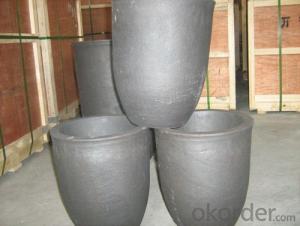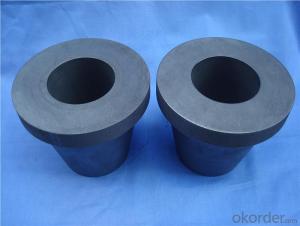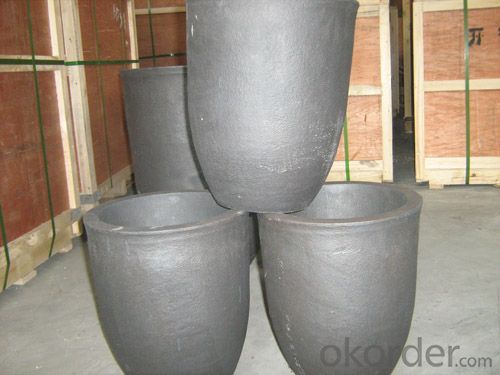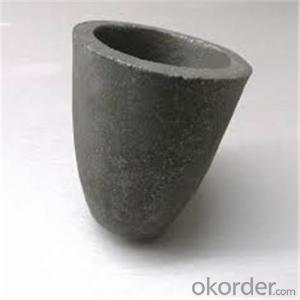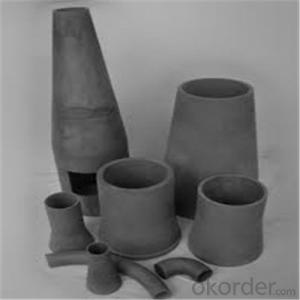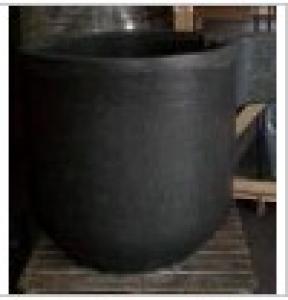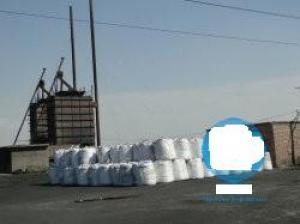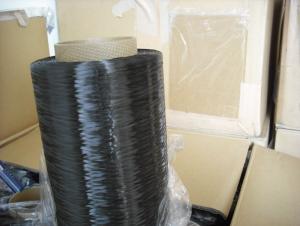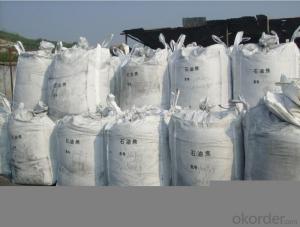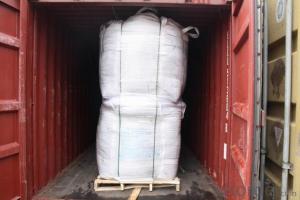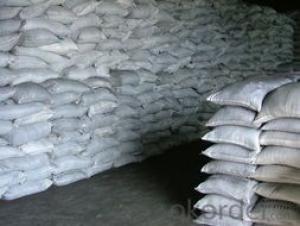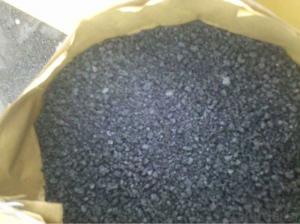Ceramic Graphite Crucibles/CNBM Ceramic Crucibles For Melt Aluminum
- Loading Port:
- China main port
- Payment Terms:
- TT OR LC
- Min Order Qty:
- 0 m.t.
- Supply Capability:
- 100000 m.t./month
OKorder Service Pledge
OKorder Financial Service
You Might Also Like
Features
1.Material:high pure graphite
2.Used for metal melting
3.Long life and good property
Product Description
The material of graphite crucible can be divided into artificial graphite,clay bonded graphite, and carbon bonded graphite.Artificial graphite crucible is made of graphite electrode as material and made out.
Clay bonded graphite, the main ingredient is natural crystal graphite and clay Now only used in small amount of high-temperature melting of cast iron, cast steel melting and melting of precious metals.
Carbon bonded graphite, the main ingredient is natural crystal graphite and silicon carbide. Mainly used in the melting of the majority of non-ferrous metals such as copper alloy and aluminum alloy.
Specification
a. High thermal conductivity
b.Thermal shock resistance
c.High temperature resistance
d.Corrosion resistance
d. Mechanical shocks resistance
d. Oxidation resistance
e. Anti-adhesive
f. Small metal contamination
g. Good clearner
Bulk Density | g/cc | 1.70-1.88 |
Specific Resistance | μΩ.m | 6.0-15.0 |
Compressive Strength | MPa | 30-80 |
Bending Strength | MPa | 20-45 |
Shore hardness | 30-70 | |
C.T.E.(100-600°C) | x10-6 /°C | 2.5-5.5 |
Ash | % | 0.01-0.2 |
Maximum Grain Size | mm |
Picture
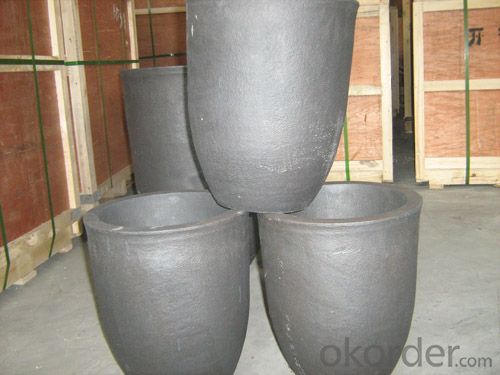
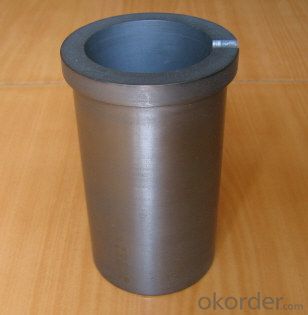
- Q: What is carbon neutral?
- Carbon neutral refers to achieving a state where the amount of carbon dioxide emitted into the atmosphere is balanced with the amount that is removed or offset. It is a widely used term in the context of addressing climate change and reducing greenhouse gas emissions. To become carbon neutral, one must first assess their carbon footprint, which involves calculating the greenhouse gases produced through activities like energy consumption, transportation, and waste management. Once the emissions are identified, steps are taken to decrease them through various methods, such as improving energy efficiency, utilizing renewable energy sources, and adopting sustainable practices. Although it is challenging to completely eliminate carbon emissions, it is crucial to reduce them. In cases where complete elimination is not possible, carbon offsets can be employed to compensate for the remaining emissions. Carbon offsets involve investing in projects that reduce or remove greenhouse gases from the atmosphere, like reforestation, renewable energy initiatives, or methane capture projects. By achieving carbon neutrality, individuals, organizations, or activities can assert that they are not contributing to the increase of greenhouse gases in the atmosphere. This is a significant objective in the battle against climate change, as it helps mitigate the adverse effects of carbon emissions and promotes a more sustainable and environmentally friendly future.
- Q: How does carbon contribute to the strength of concrete?
- There are several ways in which carbon can contribute to the strength of concrete. One primary method involves the utilization of carbon nanotubes (CNTs) or carbon fibers. These substances are added to the concrete mixture to act as reinforcement and enhance its mechanical properties. Incorporating CNTs or carbon fibers into the concrete results in the formation of a network consisting of small, sturdy, and lightweight particles. This network serves to enhance the overall strength and durability of the concrete, making it more resistant to cracking, flexing, and other types of structural damage. Furthermore, the carbon particles also improve the bonding between the cement paste and the aggregates in the concrete. This improved bonding increases the strength at the interface, resulting in a more cohesive and robust concrete matrix. Moreover, carbon can also contribute to the strength of concrete by acting as a pozzolan. Pozzolans are materials that undergo a chemical reaction with calcium hydroxide, a byproduct of cement hydration, to form additional cementitious compounds. These compounds fill in the gaps between cement particles, leading to a denser and stronger concrete structure. Carbon black, which is a finely divided form of carbon, is commonly used as a pozzolan in concrete mixtures. Overall, the incorporation of carbon in concrete, whether through carbon nanotubes, carbon fibers, or as a pozzolan, can significantly enhance its strength and performance. By reinforcing the concrete matrix, improving bonding, and filling in gaps, carbon helps create a more durable and robust material suitable for various construction applications.
- Q: What is carbon black pigment?
- Carbon black pigment is a fine black powder derived from the incomplete combustion of hydrocarbons. It is primarily composed of elemental carbon and is widely used as a pigment in various industries, including rubber, plastics, inks, coatings, and cosmetics, to impart a deep black color and enhance the strength and durability of the materials it is incorporated into.
- Q: What is a carbon free martensite?
- The definition of martensite of Fe based alloy (solid steel and other iron-based alloy) and non ferrous metals and alloys, is guetche variant diffusion free phase transition product of martensitic transformation. It is a product of Fe based alloy, phase transformation of undercooled austenite occurs without diffusion were guetche formation of martensite variant body transformation.
- Q: How is carbon used in the agricultural industry?
- Carbon is widely used in the agricultural industry for various purposes. One of the main uses of carbon in agriculture is as a soil amendment. Adding carbon-rich organic matter, such as compost or manure, to the soil improves its structure, fertility, and overall health. This is because carbon helps to increase the soil's ability to retain moisture, nutrients, and beneficial microorganisms, which are essential for plant growth. In addition to soil amendment, carbon is also used in the form of carbon dioxide (CO2) for greenhouse enrichment. In controlled environments like greenhouses, plants require a higher concentration of CO2 to enhance their growth and productivity. Carbon dioxide is released into the greenhouse to maintain optimal levels, which promotes photosynthesis and accelerates plant growth. Moreover, carbon-based fertilizers are commonly used in agriculture. These fertilizers, such as urea or ammonium nitrate, provide essential nutrients to crops and enhance their productivity. Carbon is an integral component of these fertilizers, aiding in the controlled release of nutrients and their effective uptake by plants. Furthermore, carbon is utilized in the production of pesticides and herbicides. Many of these agricultural chemicals contain carbon compounds that are specifically designed to target and control pests, diseases, and weeds that can harm crops. Carbon-based chemicals are often used because of their effectiveness and ability to break down naturally without causing long-term harm to the environment. Overall, carbon plays a crucial role in the agricultural industry by improving soil fertility, enhancing plant growth, and aiding in pest control. Its versatile applications make it an essential resource for sustainable and efficient farming practices.
- Q: How does carbon contribute to the flavor of food?
- Carbon, in the form of charcoal or charred substances, can contribute to the flavor of food in several ways. Firstly, when food is grilled or roasted over charcoal, the carbon imparts a smoky flavor to the food, enhancing its taste and aroma. This smokiness is particularly desirable in foods like barbecued meats, vegetables, or even certain cheeses, as it adds a distinct and enjoyable element to the overall flavor profile. Furthermore, carbon can also act as a natural filter, absorbing and removing impurities from food and beverages. This filtration process can help eliminate unpleasant odors and flavors, resulting in a cleaner and more refined taste. For example, activated carbon is commonly used in the production of alcoholic beverages like whiskey or vodka to remove impurities and create a smoother, more flavorful drink. In addition, carbon can contribute to the development of desirable texture and color in certain foods. When sugar or other carbohydrates are heated, they undergo a process called caramelization, where the sugars react with heat to form a complex mixture of carbon compounds. This caramelization process creates rich, golden-brown hues and a unique depth of flavor, enhancing the overall taste experience. Lastly, carbon can also play a role in the fermentation process, which is essential in the production of various foods and beverages. During fermentation, microorganisms consume sugars and release carbon dioxide, which contributes to the texture, flavor, and carbonation of the final product. This is particularly evident in bread, beer, wine, and other fermented foods where the presence of carbon dioxide adds lightness, complexity, and effervescence to the flavor profile. In summary, carbon contributes to the flavor of food through its ability to impart smokiness, act as a natural filter, facilitate caramelization, and participate in fermentation processes. Its presence in various forms enhances the taste, texture, and overall enjoyment of a wide range of food and beverages.
- Q: How do you stick carbon fabric?
- 3. Apply the base resin(1) the main agent and curing agent base resin according to the provisions of the proportion accurate weighing were put into the container, use a blender to mix uniformly. A harmonic volume should be in use within the time spent more than can be used as the standard, time cannot be used.(2) apply the base coat evenly with a roller brush(3) refers to the drying time, due to different temperatures, generally between 3H to 1D changes(4) after the curing of the base coat, when the surface of the component has a condensation bulge, it should be polished with sandpaper. If the surface of the concrete is exposed after polishing, the bottom coating shall be applied again4, the incomplete repair of the surface of the componentThe surface depressions (honeycomb pits, holes, etc.) using epoxy putty to fill, to repair the surface. (the poor, camber angle etc.) to be filled with epoxy putty, so smooth.
- Q: What is the carbon cycle?
- The carbon cycle is a natural process that involves the movement of carbon dioxide (CO2) between the atmosphere, land, bodies of water, and living organisms. It is a vital component of Earth's ecosystem and plays a crucial role in regulating the planet's climate. The carbon cycle begins with the absorption of CO2 by plants during photosynthesis. Plants take in CO2 from the atmosphere and convert it into organic compounds, such as glucose, which they use for growth and energy. This process is known as carbon fixation. Consumers, such as animals, obtain carbon by consuming plants or other animals that have already incorporated carbon into their tissues. When plants and animals respire, they release CO2 back into the atmosphere, completing the first part of the cycle. Another pathway in the carbon cycle is the decomposition of organic matter by decomposers, such as bacteria and fungi. During decomposition, carbon is released as CO2 or enters the soil as organic carbon. This stored carbon can be later released back into the atmosphere through microbial respiration or erosion. The carbon cycle also involves the exchange of carbon between the atmosphere and bodies of water. When CO2 dissolves in water, it forms carbonic acid, leading to ocean acidification. Marine plants, such as algae and phytoplankton, play a crucial role in the cycle by photosynthesizing and absorbing CO2 from the water. Additionally, geological processes such as volcanic activity and weathering also release carbon into the atmosphere. Over long periods of time, carbon can be stored in the Earth's crust as fossil fuels, such as coal, oil, and natural gas. When these fossil fuels are burned for energy, they release large amounts of CO2, contributing to the greenhouse effect and climate change. The carbon cycle is a continuous and intricate process that maintains a delicate balance of carbon in the Earth's atmosphere and ecosystems. However, human activities, particularly the burning of fossil fuels and deforestation, have significantly altered this balance by releasing excessive amounts of CO2 into the atmosphere. This disruption of the carbon cycle has led to global warming and other environmental issues, highlighting the importance of understanding and mitigating human impacts on this vital natural process.
- Q: There are several allotropes of carbon
- Allotrope of carbon: diamond, graphite, carbon 60 (fullerene), amorphous carbon (charcoal, coke, activated carbon, etc.)
- Q: Learn photography for nearly half a year, has always wanted to buy a tripod, want to buy carbon fiber tripod, what brand is better? The machine is D700+24-70About 3000 is too expensive ~ consider 1000 more just fine. Wage earners!
- The three tripod has such a word: buy third tripod to know the first two are white bought!This sentence is a lot of friends with real money summed up, and hope to see!The three tripod is the most important, safe and reliable, and then the price, can not guarantee the safety of equipment, the price is cheaper and useless.The more than 1000 budget recommendations for the selection of source or berno, quality guaranteed, price is also good. If not on the cannon, not in harsh environment, the maximum diameter of 25mm, 4 section can also (cheap).Finally: carbon fiber hundreds of three tripod is not necessarily not, but never heard of this three foot will drop the camera, my answer can only represent personal views, for a reference.
Send your message to us
Ceramic Graphite Crucibles/CNBM Ceramic Crucibles For Melt Aluminum
- Loading Port:
- China main port
- Payment Terms:
- TT OR LC
- Min Order Qty:
- 0 m.t.
- Supply Capability:
- 100000 m.t./month
OKorder Service Pledge
OKorder Financial Service
Similar products
Hot products
Hot Searches
Related keywords
